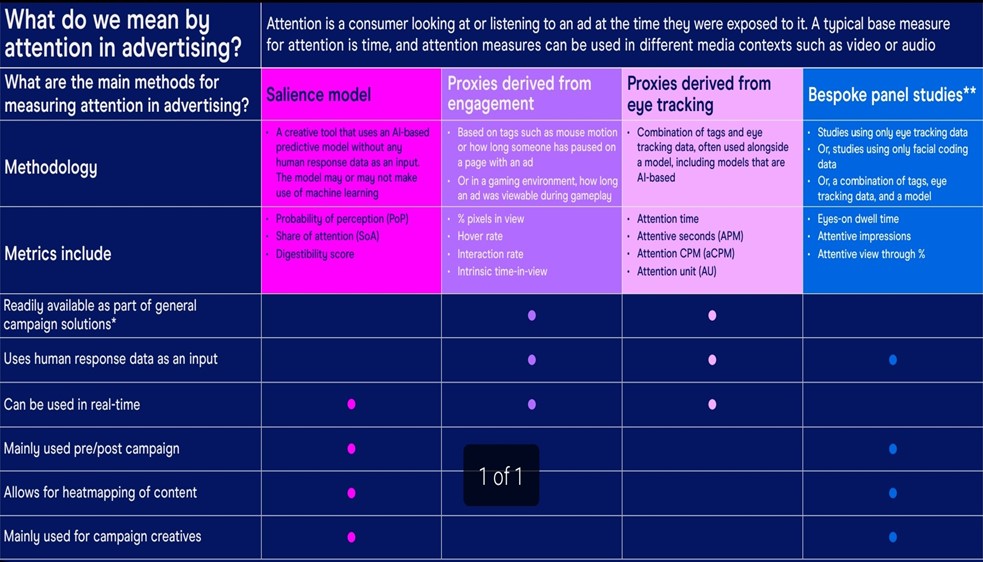Attention measurement, the best of both
20 February 2024

Rob Turnbull, Insights lead at Samsung Ads
Rob is a research and data professional with over 9 years experience in advertising and marketing, having previously worked at X (formerly Twitter). He leads the Insights & Data Solutions team in EMEA at Samsung Ads, where he currently works to unveil insight into rapidly evolving consumer habits in Connected TV.
As part of the MRS Advanced Insights and Analytics Council, our mission is to spotlight the convergence between what we as research practitioners recognise as traditional forms of market research and the ever-expanding universe of data analytics. Attention measurement, as it’s understood today, is a perfect encapsulation of this. It has captivated both big brands and media agencies alike in the last few years and is a great example of emerging “best of both” approaches we continue to see trending across our industry (see table at end of article for an explanation of some of the methods used today, from the IAB (Internet Advertising Bureau) UK)
At its core, attention measurement is a research study of the interactions between real people and ads. Its rise owes to the evolution in supporting software and the ubiquity of cameras — first in webcams and later, in the accessory of our time, the mobile phone. Both of these being essential to eye-tracking, which is the key method of the current practice.
Clearly the observation of interactions with ads through cameras and follow-up surveys isn’t new but what has made a great impact is the more recent increases in accuracy & scalability of eye-tracking tech and the identification of measurable proxies, both having been revolutionised by adoption of cutting-edge machine learning techniques. Metrics like viewability, time-in-view, contextual alignment, scroll time, click-through and audio volume (amongst many others) can now confidently be used to predict attention. Because of this, ads may now be tagged to trigger pixels - these relay measurements back to ad servers for calculation of “attention scores”, giving brands and agencies the opportunity to optimise toward creatives and placements that receive the highest attention.
The IAB UK has underscored this in recent publications, stating, "Attention is a versatile metric applicable across various formats, from video to audio. Its potential extends into understanding consumer engagement with emerging digital formats like gaming, CTV (Connected TV), and AR (Augmented Reality) or VR (Virtual Reality)."
Interest in integrating attention into the standard suite of campaign effectiveness studies has surged in the UK since 2022, accompanied by an increase in the number of vendors offering their services. So much so, the IAB has spent much of 2023 trying to unite the industry under a common set of attention standards.
Some might argue against adding another way of measuring campaigns, in addition to an already packed suite of solutions. New metrics amongst so many others might just complicate and contradict. However, proven correlation with outcomes over and above common metrics like viewability offers us an insight into the potential for attention to drive a real reduction in waste. This could be crucial amid the prolonged death of cookies, as well as the hyper focus on ROI due to short term pressures like the cost of living crisis and long term targets for sustainability and net-zero advertising. Not only this, but also addresses the issue surrounding our ever-decreasing attention spans.
Tom Coombes, Research Director at Boxclever recently delivered a webinar on ‘Stolen Focus’ and why it matters, and commented:
“We live in a world where we are constantly bombarded by external stimulus and different things constantly vying for our attention. The detrimental impact on our attentiveness is obvious, with some studies suggesting that younger generations now have an average attention span of 8 seconds. Finding a more accurate way of measuring cut through has never been more important for us as an industry. Attention measurement is critical for creative measurement generally and for allowing brands to make the most of the creative they put out there.”
Overall, researchers can take solace in the fact that this burgeoning method is rooted in a rich history of attention research by practitioners. It exemplifies the advantage of supercharging research using analytics to produce answers to the most important challenges brands will face, and solidifies the case for both researchers and data scientists to work together, continuing to offer a “best of both” approach to their collective benefit.

Get the latest MRS news
Our newsletters cover the latest MRS events, policy updates and research news.











0 comments